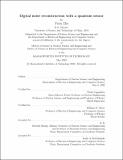| dc.contributor.advisor | Cappellaro, Paola | |
| dc.contributor.author | Zhu, Yuan | |
| dc.date.accessioned | 2022-08-29T16:07:26Z | |
| dc.date.available | 2022-08-29T16:07:26Z | |
| dc.date.issued | 2022-05 | |
| dc.date.submitted | 2022-06-17T16:03:40.943Z | |
| dc.identifier.uri | https://hdl.handle.net/1721.1/144725 | |
| dc.description.abstract | Interactions between a quantum system and its environment are usually inevitable and could lead to decoherence limiting the performance of quantum devices. On the one hand, to build robust quantum devices requires an in-depth characterization of such decoherence mechanism. On the other hand, the extracted environmental information brings us new approaches to investigate novel phases in quantum materials. Thus, probing and characterizing environmental noise is an essential task for both fundamental physics and quantum applications. Existing noise reconstruction methods in quantum systems rely on using approximated delta-like frequency filtering to sample the noise spectrum in frequency domain using dynamical decoupling sequences.
In this thesis, we propose a novel digital noise reconstruction method to reconstruct the environmental noise both in frequency and time domains, which avoids the delta function approximation for frequency filtering. By measuring the decoherence of a qubit sensor under a set of Walsh modulation sequences, the (arithmetic) auto-correlation of a stationary Gaussian noise that couples to the quantum sensor is directly reconstructed and the corresponding noise spectrum is then reconstructed through linear transformations (discrete Fourier transform).
We systematically compare the typical dynamical decoupling-based noise reconstruction method (the Carr-Purcell-
Meiboom-Gill reconstruction method) and the Walsh reconstruction method by evaluating the reconstruction errors of both methods under an Orstein-Unlenbeck noise model, which is commonly adopted to describe the magnetic noise generated by a dipolarly coupled spin bath. Combining theoretical and simulation results, we conclude that the accuracy of our Walsh reconstruction method is only limited by the time-space sampling and can be easily suppressed by increasing the reconstruction order.
We then perform a proof-of-principle demonstration using a single nitrogen-vacancy center in diamond to characterize its environmental noise dominated by the carbon-13 nuclear spin bath, and discuss the practical limitations of the reconstruction accuracy and avenues for its improvement. Finally we also introduce several directions of interest for future research. | |
| dc.publisher | Massachusetts Institute of Technology | |
| dc.rights | In Copyright - Educational Use Permitted | |
| dc.rights | Copyright MIT | |
| dc.rights.uri | http://rightsstatements.org/page/InC-EDU/1.0/ | |
| dc.title | Digital noise reconstruction with a quantum sensor | |
| dc.type | Thesis | |
| dc.description.degree | S.M. | |
| dc.description.degree | S.M. | |
| dc.contributor.department | Massachusetts Institute of Technology. Department of Electrical Engineering and Computer Science | |
| dc.contributor.department | Massachusetts Institute of Technology. Department of Nuclear Science and Engineering | |
| mit.thesis.degree | Master | |
| thesis.degree.name | Master of Science in Electrical Engineering and Computer Science | |
| thesis.degree.name | Master of Science in Nuclear Science and Engineering | |
